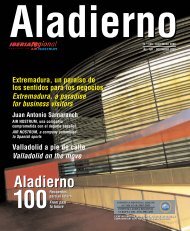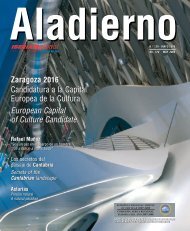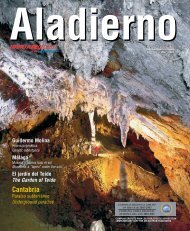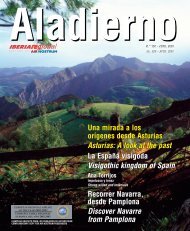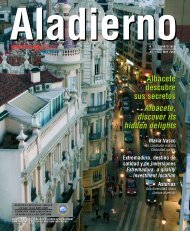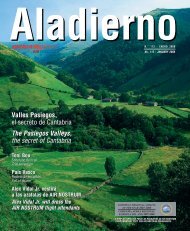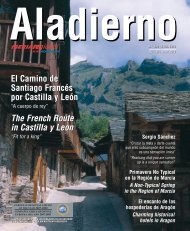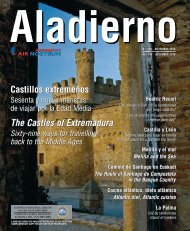Create successful ePaper yourself
Turn your PDF publications into a flip-book with our unique Google optimized e-Paper software.
Al mismo tiempo, los franceses modernizaron la fiscalidad, de forma que se<br />
gravó más a los ricos por sus propiedades. De hecho, según los historiadores, la<br />
provincia nunca recaudó más dinero que en aquella época.<br />
Se instalaron bibliotecas públicas en todo el País Vasco (en Los Arquillos, por<br />
ejemplo, se abrió la primera librería de la ciudad con préstamo de volúmenes); se<br />
llevó a cabo una campaña de vacunación general y se promovieron los entierros en<br />
cementerios apartados, fuera de las iglesias (como es el caso del de Santa Isabel).<br />
De igual manera, se creó un gran ambiente nocturno en algunas calles del casco<br />
medieval y se celebraron fiestas, bailes de gala y cenas lujosas. Mientras, los ciudadanos<br />
que no eran nobles se morían de hambre, se les obligaba a pagar unas<br />
“contribuciones” económicas excesivas y sufrían constantes confiscaciones de<br />
productos. Esto provocó una gran escasez de alimentos para la población y, en<br />
consecuencia, una subida de precios que acabaría destruyendo la economía local.<br />
Durante los años de la ocupación hubo, además, un fuerte movimiento de resistencia<br />
interno en la provincia, que estuvo liderado por varios guerrilleros, entre los que<br />
se encontraban Sebastián Fernández de Lezeta (alias Dos Pelos), los hermanos Eustaquio<br />
y Fermín Salcedo, o Francisco de Longa. Para los historiadores, se trató de una<br />
ocupación muy dura, si bien no se registraron grandes ejecuciones de rebeldes.<br />
FOTOGRAFÍAS / PHOTOGRAPHS:<br />
Superior: Huida. Imagen cedida por el Archivo Municipal del Vitoria-Gasteiz<br />
Above: Photograph provided by the Diputacion Foral of Alava Arms Museum.<br />
Superior derecha: Imagen cedida por el Museo de Armería de la Diputación Foral<br />
de Álava. Fotografía de Quintas Fotógrafos.<br />
Above right: Flight. Photograph provided by the Victoria-Gasteiz Municipal<br />
Archive. Photography by Quintas Fotógrafos.<br />
Inferior derecha: Imagen cedida por el Museo de Armería de la Diputación Foral<br />
de Álava. Fotografía de Quintas Fotógrafos.<br />
Below left: Photograph provided by the Diputacion Foral of Alava Arms Museum.<br />
Photography by Quintas Fotógrafos.<br />
At the same time, the French modernised the tax system so the rich would<br />
pay more taxes on their properties. In fact, according to historians, the province<br />
collected more revenue during that period than in any other.<br />
Public libraries were created throughout the Basque Country, such as the<br />
first library for lending books, which opened in Los Arquillos.<br />
A wide-spread vaccination campaign was carried out. Burials were<br />
encouraged in cemeteries on the outskirts of the city rather than outside the<br />
churches, as in the case of the Santa Isabel cemetery.<br />
The night-life in some streets of the old medieval quarter became very lively,<br />
with parties, dance galas and fine dinners. Meanwhile, the populace were dying<br />
of hunger. They were forced to pay onerous taxes and their produce was<br />
frequently confiscated. Food was scarce among the population and the resulting<br />
rise in prices ended up destroying the local economy.<br />
Furthermore, during the French occupation there was a strong internal<br />
resistance movement, headed by several guerrilla leaders, including Sebastián<br />
Fernández de Lezeta (alias Dos Pelos), the brothers Eustaquio and Fermín<br />
Salcedo, and Francisco de Longa. In the opinion of many historians, it was a<br />
very harsh occupation, although there were no large-scale executions of rebels.<br />
VISITAS RECOMENDADAS/RECOMMENDED VISITS<br />
VISITA LA BATALLA DE VITORIA: “CONMEMORACIÓN DEL BICENTENARIO”<br />
VISIT THE BATTLE OF VITORIA: “BICENTENNIAL COMMEMORATION”<br />
Días/Date: 6 y 7 de abril. / 6th & 7th April.<br />
Hora/Time: 12: 15 h. / 2:15 hours.<br />
Lugar de salida/Departure Point: Oficina de Turismo. / Tourism Office.<br />
Precio/Price: 7 € con visita incluida al Museo de Armería. / 7 € including<br />
visit to the Arms Museum.<br />
SANTA MARÍA 1813. MÁS ALLÁ DE LOS FUSILES Y LAS BAYONETAS<br />
SANTA MARIA 1813. BEYOND RIFLES AND BAYONETS<br />
La Fundación Catedral Santa María desde el pasado sábado 23 de marzo<br />
ofrece visitas con la Batalla de Vitoria de fondo. Estas visitas no se centran<br />
en la propia actividad bélica, sino que se explican otro tipo de detalles de<br />
ese momento histórico en la Catedral de Santa María.<br />
The Cathedral of Santa Maria has, since 23rd March, been offering visits<br />
with the Battle of Vitoria as the backdrop. The visits are not centred on the<br />
war activity, but rather on other types of information that reflect this<br />
moment in the historical Cathedral of Santa Maria.<br />
Horario/Visits: A las 12:45 h. y a las 17:30 h. / At 12:45 and 17:30 hours.<br />
Información y reservas/Information and reservations: 945 255 135.<br />
Precio/Price: 10,5 € personas adultas.<br />
OFICINA DE TURISMO/TOURIST OFFICE:<br />
Plaza de España, 1 / Tel. 945 16 15 98 · Fax. 945 16 11 05 / E-mail: turismo@vitoria-gasteiz.org / www.vitoria-gasteiz.org/turismo<br />
30 <strong>Aladierno</strong> • Abril 2013 April



